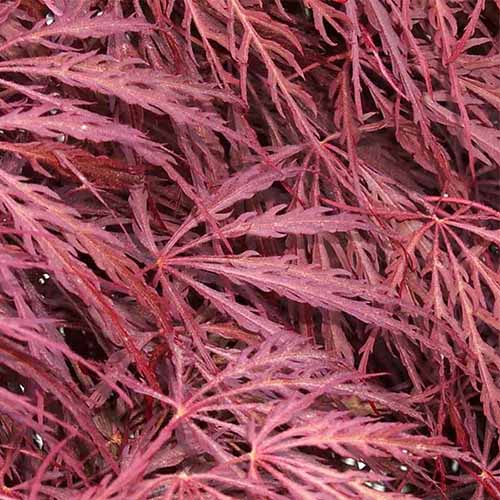Acer palmatum var. dissectum ‘Crimson Queen’
‘Crimson Queen’ ticks all the boxes on the list of what gardeners love about Japanese Maples.
It’s a dwarf tree, features shockingly bright red fall foliage, has lace-like serrated leaves, and grows in a cascading habit that creates a unique focal point in the garden.
‘Crimson Queen’ is essentially that quintessential cascading red Japanese maple with lacy leaves.
If that’s just what your landscape needs, ‘Crimson Queen’ has to be near the top of your list of Japanese maple cultivars.
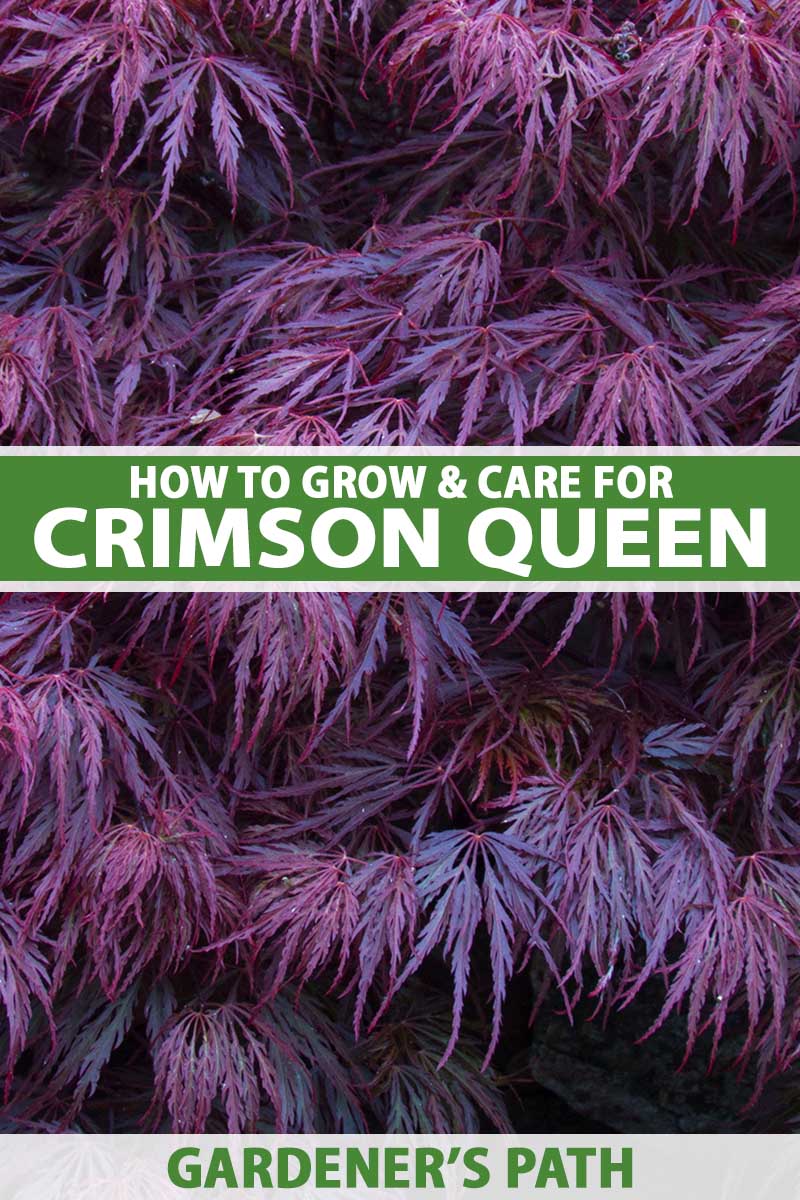
We link to vendors to help you find relevant products. If you buy from one of our links, we may earn a commission.
It’s not a perfect tree, though. It does have a few special requirements if you want it to look its best. Don’t worry, we’ll go over all of the pros and cons of this garden favorite.
Part of what I love about ‘Crimson Queen’ is that after the beautiful foliage is done for the year, the twisting branches add visual interest to the winter landscape, and the shape becomes more impressive as the trees age.
If you’re in USDA Hardiness Zones 5 to 8, you’re in luck. ‘Crimson Queen’ can be yours. Coming up, here’s what we will chat about to help you get to know Her Royal Highness:
What You’ll Learn
Can’t wait one minute more? Then let’s jump right in.
Cultivation and History
‘Crimson Queen’ is a weeping Japanese maple cultivar. It’s a standout in the dissectum category, which you can learn more about in our guide to Japanese maple types.
Trees in this group tend to be much smaller than the species and have a more shrubby shape, often with a cascading habit.
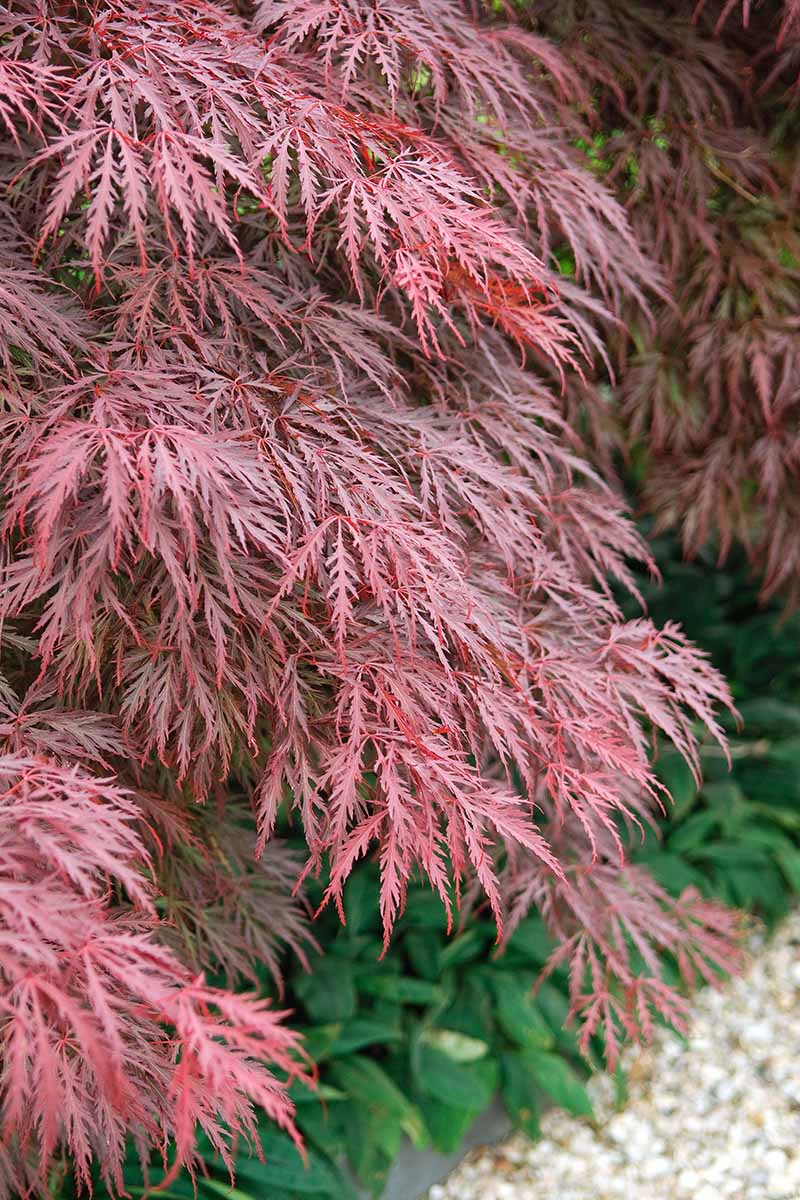
‘Crimson Queen’ was bred in the United States in 1965, and rapidly became a commercial success. It won the RHS Award of Garden Merit in 1993.
This dwarf cultivar takes about 15 years to grow to its mature size of about five feet tall and seven feet wide, which may seem slow, but that’s about the average growth rate for any Japanese maple.
It can get a bit taller with ideal sun exposure and moisture, but usually, it doesn’t grow much taller than five feet. It’s common for the tree to stay much smaller if it’s planted in a shady spot.
If you aren’t afraid of a little pruning, you can train it to be shorter or taller than it would be naturally, and you can encourage a bushier shape or a more upright one.
Looking for a good container option? You found it. The small size and cascading shape of ‘Crimson Queen’ makes it ideal for life in a pot.
When the leaves first emerge in the spring, they unfold into a deep purple-red and shift to bright red over the span of a few weeks. It’s almost like fall in the springtime, and the foliage makes a beautiful contrast to all the bright spring colors.
It lightens just slightly during the summer before putting on a fall show with a bright, fire-engine-red hue.
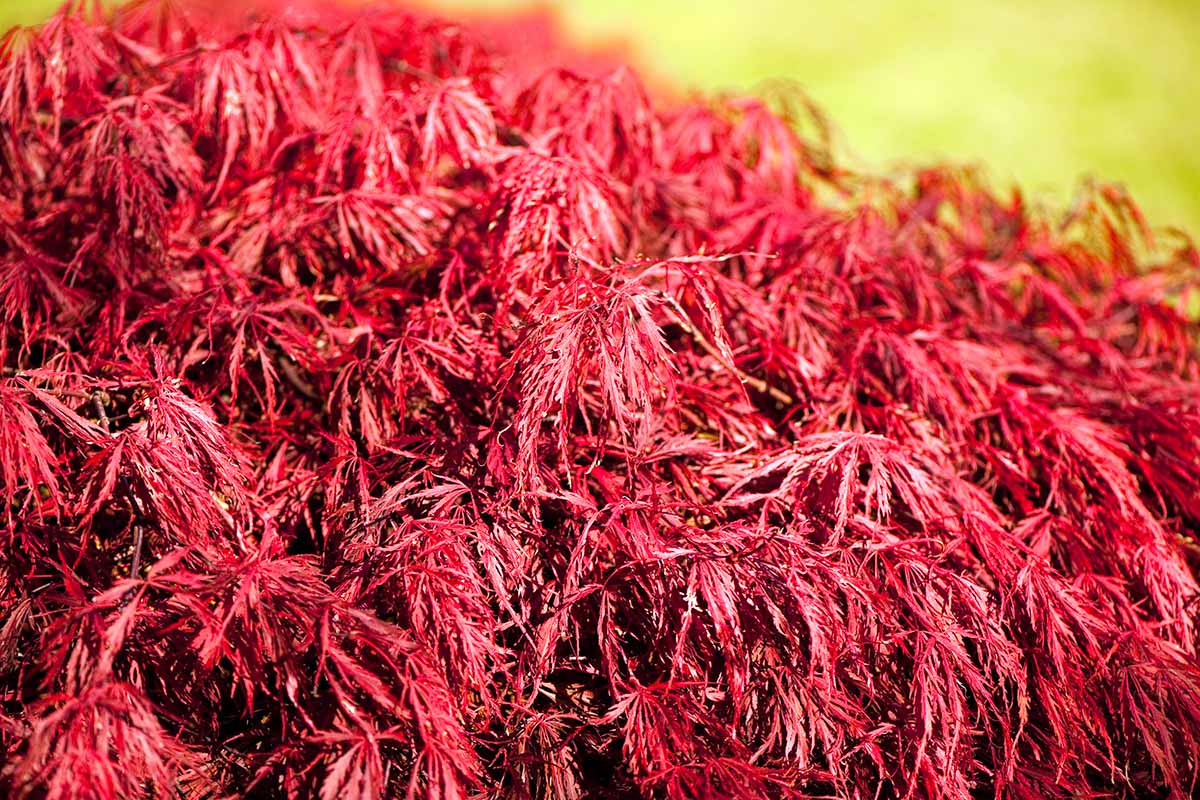
‘Crimson Queen’ is beloved for its ability to retain its color all summer long, with the exception of occasional leaf scorch or loss of color in hot, sunny areas.
In hot regions, it might take on more of a bronze-green hue in the summer, especially if it’s growing in direct sun.
The leaves are palmate, deeply lobed, finely dissected, with seven to nine lobes, and grow up to four inches long and wide.
The insignificant flowers appear in the spring and give way to samaras with two wings.
Crimson Queen Propagation
‘Crimson Queen,’ as with many cultivated varieties, won’t grow true from seed.
They are usually grafted rather than grown from seed. Feel free to give it a try if that’s something that interests you – with the understanding that you never know what you might get.
Our guide will walk you through the entire process.
Otherwise, stick to planting purchased plants or taking cuttings. Cuttings don’t always take, so plan on starting multiples just in case a few don’t turn out.
Our guide to growing weeping Japanese maples will walk you through both planting a purchased plant and propagation via cuttings.
The best time of year to do either is the spring or fall. With a newly planted tree, be sure to keep the soil moist but not wet for the first year. The soil should have the same texture as a kitchen sponge that you’ve wrung out really well.
Space trees four feet away on all sides from buildings, other plants, or fences.
How to Grow Crimson Queen Japanese Maple
As with most Japanese maples, this one grows best in loamy, rich, moist soil. It will also tolerate sandy loam. The soil should be slightly acidic, with a pH between 5.5 to 6.5.
After the first year, when the soil should be kept consistently moist, you can allow the top few inches of soil to dry out between waterings.

An inch or two of organic mulch, like well-rotted compost or shredded bark, can help the soil retain moisture and it also helps to suppress weeds.
Don’t build up a layer of mulch against the trunk, though. Keep it a few inches away from the trunk itself.
Remember how we talked about the downside of ‘Crimson Queen?’ We’ve come to that part. She’s prone to scorching. If her soil is allowed to dry out or she is planted in a location with too much sun, the leaves will shrivel, turn yellow or brown, and look shabby on the “fingers.”
You can avoid scorching in some trees by keeping them moist and providing afternoon shade. But even if you do that, the tree might still experience leaf scorch during very hot weather.
This tree really does best in a location with temperate summers, but if you give it afternoon protection from the sun, it should do fine even in warmer regions. If the leaves do suffer from scorch, they will eventually drop, and new foliage will replace them.
That’s all to say that you should plant in partial sun with shade in the afternoon, or in full sun if it doesn’t get too sweltering in the summer in your neck of the woods.
Those in regions with cooler summers like the Pacific Northwest or the northern Atlantic coast can grow these in full sun. If you’re in the West or Midwest, best to provide afternoon shade.
Water is an important part of keeping a ‘Crimson Queen’ happy during the heat, so stay on top of your irrigation routine during warm weather.
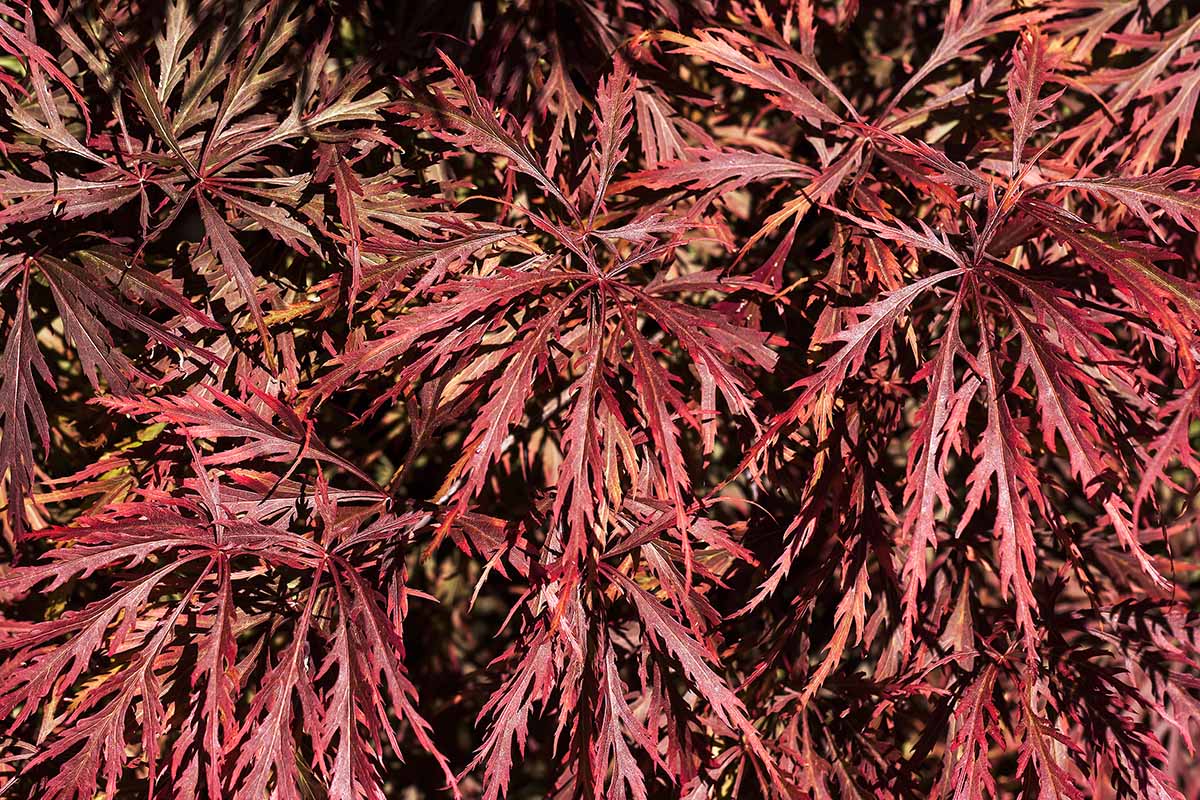
I know I said that this tree is suitable for Zones 5 to 8, but you can grow it in Zone 4 if you choose your planting site carefully.
Place it close to a south-facing wall that is protected from strong winds with a cement or brick foundation which will help to keep the roots warm. Add a thick layer of organic mulch in the fall to help protect the roots.
‘Crimson Queen’ maintains a compact size naturally, so it lends itself to container growing. Avoid using light pots made out of plastic or thin metal.
You need something fairly hefty so the tree doesn’t tip over in high winds. A pot about two feet in diameter that’s slightly wider than it is tall would be ideal.
Fill the container with a standard potting mix. If you don’t have a favorite already, I swear by FoxFarm Ocean Forest potting mix.
It contains earthworm castings, bat guano, fish meal, sphagnum peat moss, and forest humus, which is an ideal combination for Japanese maples.

FoxFarm Ocean Forest Potting Mix
Pick up bags in 12-quart sizes at Amazon.
Keep in mind that containers tend to dry out more quickly than the soil in the ground, so keep a sharp eye on your tree or install a drip irrigation system.
Our guide to growing Japanese maples in containers has more information.
Speaking of irrigation, whether in the ground or a container, avoid splashing water on the leaves. Water should be applied at the ground level to decrease the chances of fungal diseases.
You likely won’t ever need to fertilize your Japanese maple, but if you notice your tree seems to be extremely slow-growing or stunted, do a soil test to check if your soil is deficient in certain nutrients. If it is, amend your soil with the missing nutrients.
If you know your soil is lacking in nutrients, feel free to feed your plant following our guide.
Growing Tips
- Plant in full sun in cooler climates or afternoon shade in warm climates.
- Water when the top two or three inches of soil dry out.
- Keep plants well-watered during high heat.
Pruning and Maintenance
All Japanese maples need regular pruning to maintain their beautiful appearance, but weeping types need extra attention.
You can encourage the striking shape by pruning out the center of the tree so that there are just three to five main branches.
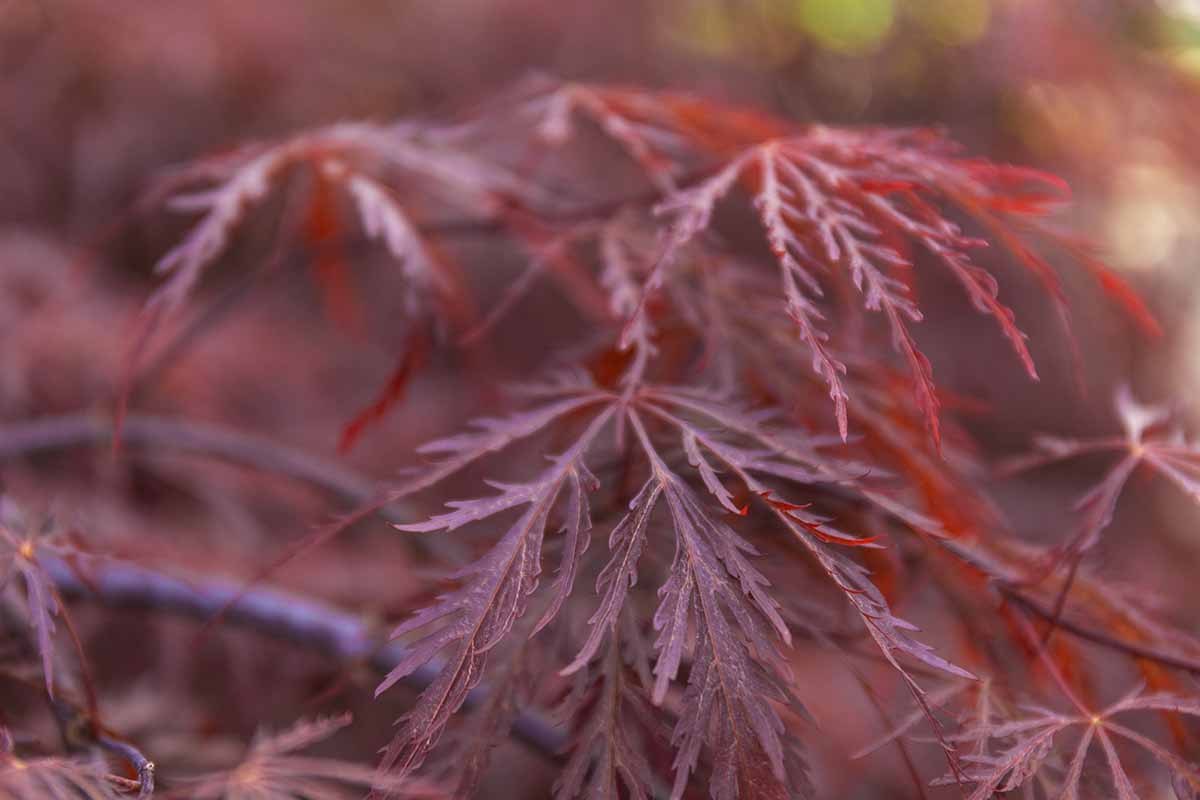
A crowded crown won’t be as dramatic as one that is carefully curated to include the most beautiful branches that contribute to the shape you want to see.
Some of the most interesting and beautiful Japanese maple specimens out there didn’t happen by chance. They were carefully pruned, especially when they were young, to create a pleasing shape.
If you were to crawl under your tree when it is in full leaf and look up, you should be able to see some sky through the leaves and branches. If you can’t, then your tree is in need of a good pruning.
You can learn all about the process by visiting our comprehensive guide to pruning Japanese maples.
Diseased, dead, dying, deformed, or damaged leaves can be pruned out anytime of year, while shaping should be done during the winter on a day when the temperature is above freezing.
Where to Buy
You can find ‘Crimson Queen’ all over the place. It’s an extremely popular option and is commonly carried by garden centers and plant nurseries.
For instance, Nature Hills Nursery has live plants in sprinter pots.
If you aren’t familiar with the term sprinter pot, it’s a pot just under a quart in size containing a tree under two years old.
Or you can grab a one- to two-foot or two- to three-foot tree from Fast Growing Trees.
Managing Pests and Disease
‘Crimson Queen’ is susceptible to all the usual common diseases and pests that attack Japanese maples.
These trees are subject to infestations from aphids, borers, and scale. Infestations can range from minor to deadly serious.
When it comes to disease, watch for anthracnose, powdery mildew, Pseudomonas, root rot, and verticillium wilt.
We cover all of these in our guide to growing Japanese maples.
General signs of a problem are yellowing or brown leaves, wilting, stunted growth, and dropping leaves.
Best Uses for Crimson Queen
‘Crimson Queen’ is the ruler of specimen plantings. Just try to look at anything else when she’s draped in her red robe in the summer.
She also makes an excellent container option, whether that’s in a large planter or a tiny little bonsai pot.
This little tree adds shape to the winter landscape and color during spring, summer, and fall.
Quick Reference Growing Guide
| Plant Type: | Deciduous tree | Foliage Color: | Red, bronze, green |
| Native to: | China, Japan, Korea | Tolerance: | Some shade |
| Hardiness (USDA Zone): | 4b-9b | Soil Type: | Sandy, loamy, silty, loamy clay |
| Season: | Spring | Soil pH: | 5.5-6.5 |
| Exposure: | Full sun to partial shade | Soil Drainage: | Well-draining |
| Time to Maturity: | 15 years | Attracts: | Birds |
| Planting Depth: | Same depth as container (graft exposed) | Companion Planting: | Black walnut, camellia, crocus, dwarf conifer, ginkgo, iris, hellebores, hosta, rhododendron |
| Spacing | 4 feet | Avoid Planting With: | Barberry, cacti, crocus, forsythia |
| Height: | Up to 8 feet | Uses: | Bonsai, container planting, specimen |
| Spread: | Up to 10 feet | Family: | Sapindaceae |
| Growth Rate: | Slow | Genus: | Acer |
| Water Needs: | Moderate-high | Species: | Palmatum |
| Maintenance: | Moderate | Variety: | Dissectum |
| Common Pests and Disease: | Aphids, borers, maple scale; Anthracnose, powdery mildew, pseudomonas, root rot, verticillium wilt | Cultivar: | Crimson Queen |
All Hail the Queen
She’s an undeniable beauty. It’s perfectly clear why she is considered one of the best options if you want a lacy, weeping, red Japanese maple.
She’s sure to draw all the attention when she’s sitting on her throne in your garden.
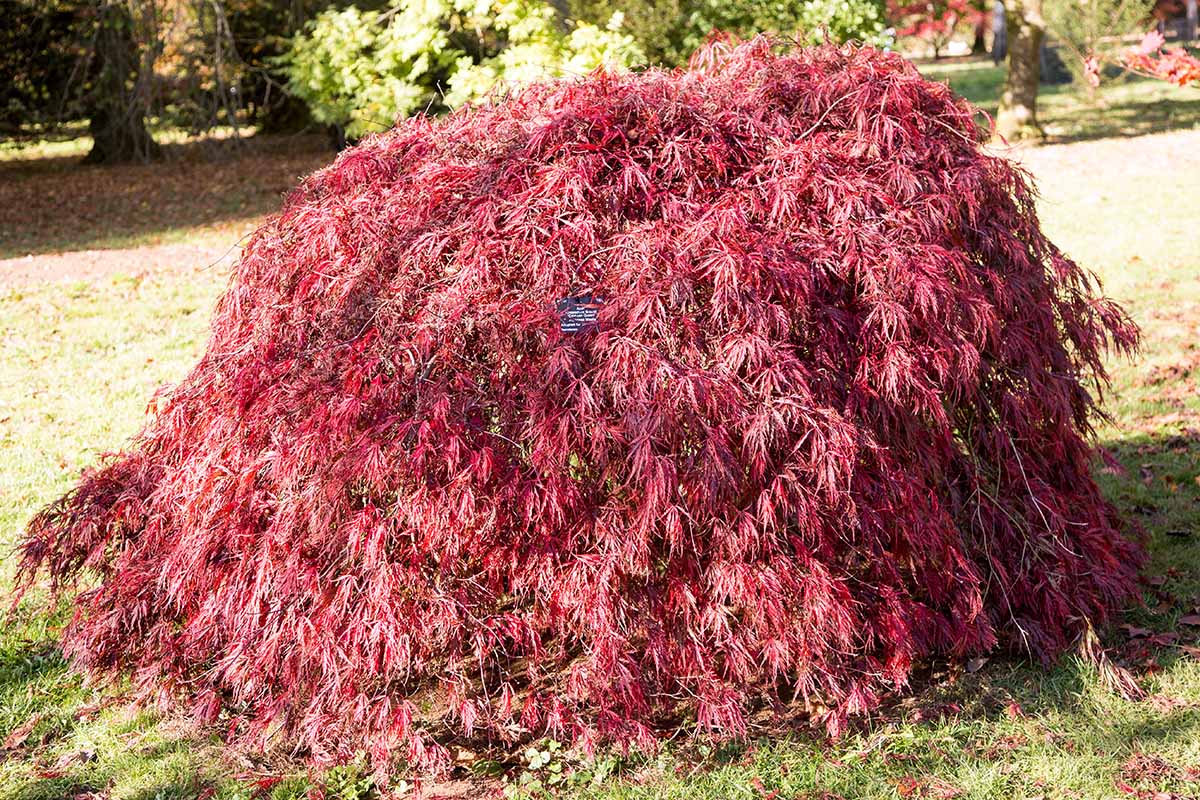
How will you highlight Her Royal Highness? Are you putting her in a container? Using her as an accent for a Japanese garden? Share your plans in the comments section below.
Don’t end your Japanese maple journey here. These plants are fascinating. Here are some guides to expand your knowledge even further:
